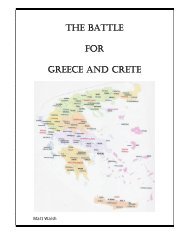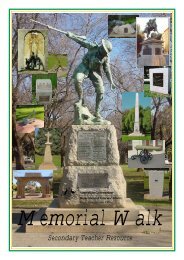Eastern Adelaide Teacher resource.pdf - Army Museum of South ...
Eastern Adelaide Teacher resource.pdf - Army Museum of South ...
Eastern Adelaide Teacher resource.pdf - Army Museum of South ...
Create successful ePaper yourself
Turn your PDF publications into a flip-book with our unique Google optimized e-Paper software.
(3) How many soldiers whose names appear on the monument lost their lives<br />
during the First World War?<br />
How many others had died by 1920 from the effects <strong>of</strong> war?<br />
Assuming these figures were reflected throughout Australia, how many<br />
Australians might have lost their lives as a result <strong>of</strong> the effects <strong>of</strong> war by<br />
1920. To assist in your calculations 60,000 Australians lost their lives<br />
during the Great War.<br />
29 died during the war and 5 due to the effects <strong>of</strong> war.<br />
5/29 X 60,000 = Approx 10,335 would have potentially died by the end <strong>of</strong> 1920 due<br />
to the effects <strong>of</strong> war if these figures represented a national trend.<br />
(4) How many surnames appear more than once on the Magill Soldiers<br />
Memorial? List these names. Note the initials <strong>of</strong> the family with the<br />
surname starting with K. These will be used for further research when you<br />
return to the classroom.<br />
The four family names that appear twice are CRABB, JURY, KENNEDY and MAIN.<br />
The Kennedy’s initials are S.C. and R.<br />
Classroom<br />
(5) Both the Australian and British flags appear on the monument. Why would<br />
the flag <strong>of</strong> another country appear on an Australian war memorial?<br />
Whilst an independent country, Australia was still a part <strong>of</strong><br />
the British Empire in the early 20 th century. Given its<br />
colonial history, in 1914 Australia, still had strong political,<br />
social, cultural, military and commercial ties with Great<br />
Britain. A sense <strong>of</strong> Australian nationalism was still<br />
emerging and many Australians still saw themselves as<br />
British and looked to the mother country for leadership,<br />
recognition and support. The epitaph, chosen by one <strong>South</strong><br />
Australian mother after the war, which appears on a grave<br />
marker at Gallipoli, reads, “He died like a Britisher”.<br />
Source: http://www.bbc.co.uk/history/war/wwone/australia_02.shtml<br />
(6) List some reasons why so many Australians were willing to enlist to serve in<br />
the First World War?<br />
There were many reasons soldiers enlisted. Some <strong>of</strong> these include:<br />
<br />
<br />
<br />
<br />
Loyalty to the British Empire.<br />
The desire for adventure.<br />
The result <strong>of</strong> friends or relatives joining up.<br />
The chance <strong>of</strong> overseas travel.<br />
32











